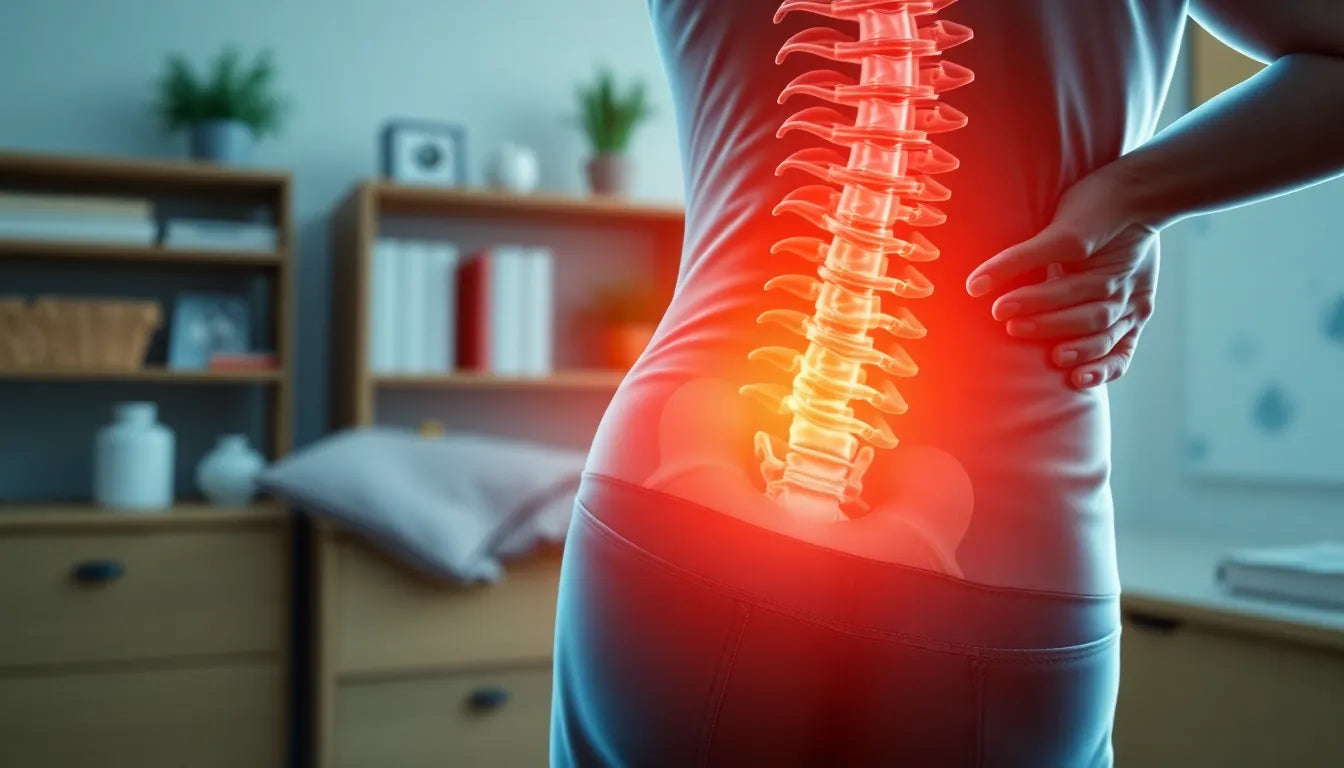Experiencing back pain or discomfort can be distressing, especially when it affects your daily routine. One common culprit behind such pain is a herniated disc, a condition that can significantly impact your quality of life if not addressed promptly. Recognizing the early signs of a herniated disc is crucial, as early detection can prevent further complications and lead to more effective management.
Understanding a herniated disc
A herniated disc occurs when the soft inner gel of a spinal disc pushes through a crack in the tougher exterior casing. This condition is often referred to as a slipped or ruptured disc and can occur in any part of the spine, though it is most common in the lower back. The pressure from the herniated material can irritate nearby nerves, leading to pain, numbness, or weakness in an arm or leg.
Herniated discs are more prevalent among adults, particularly those between the ages of 30 and 50. Factors such as age-related wear and tear, improper lifting techniques, and even genetic predispositions can contribute to the development of this condition. With its prevalence, understanding the symptoms and seeking timely medical advice becomes imperative.
The importance of early detection
Spotting the signs of a herniated disc early on can make a significant difference in managing the condition effectively. Left untreated, a herniated disc can lead to chronic pain and further spinal complications, affecting your ability to perform everyday activities. By identifying the symptoms early, individuals can seek appropriate medical care and explore treatment options that can alleviate pain and restore mobility.
This blog post aims to guide you in recognizing the signs of a herniated disc and understanding the diagnostic process. By becoming more informed about what your body is telling you, you can take proactive steps towards maintaining your spinal health and overall well-being.
Recognizing the symptoms of a herniated disc
Understanding the symptoms of a herniated disc is crucial for early detection and effective management. One of the most common symptoms is low back pain, often accompanied by sciatica, which is a sharp, burning pain that radiates from the lower back down the leg. This pain can be exacerbated by movements such as bending, lifting, or twisting.
In addition to pain, individuals may experience numbness or tingling in the leg and/or foot, which occurs when the herniated disc presses against the nerves. This sensation can extend to weakness in the leg and/or foot, affecting one's ability to walk or stand for prolonged periods.
Location-specific symptoms
The symptoms of a herniated disc can vary depending on the location of the disc in the spine. For instance, a herniated disc in the cervical region (neck) may cause pain and tingling in the shoulder, arm, or hand. Conversely, a herniated disc in the lumbar region (lower back) is more likely to affect the legs and feet.
Understanding these location-specific symptoms is important for identifying the potential area of the spine affected. In rare cases, severe symptoms such as loss of bladder or bowel control can occur, indicating a medical emergency that requires immediate attention.
The diagnostic process for herniated discs
Diagnosing a herniated disc involves a combination of physical examinations and imaging tests. During a physical examination, a healthcare professional will assess reflexes, muscle strength, and walking ability to identify any neurological deficits. They may also perform specific tests, such as the straight leg raise (SLR) test, to evaluate nerve irritation.
Imaging tests play a crucial role in confirming the diagnosis of a herniated disc. An MRI (Magnetic Resonance Imaging) is often the preferred method as it provides detailed images of the spine's soft tissues, allowing for precise identification of the herniated disc. Other imaging options include CT scans and X-rays, which can help in assessing the extent of the disc herniation and ruling out other conditions.
Additional diagnostic tools
In some cases, further diagnostic tools such as electromyography (EMG) and nerve conduction studies may be used to evaluate the electrical activity of muscles and the speed of nerve signals. These tests can help determine the specific nerves affected by the herniated disc, providing valuable information for treatment planning.
Comparison of symptoms by disc location
To assist in identifying the symptoms based on the disc location, consider the following table:
| Disc Location | Common Symptoms |
|---|---|
| Cervical (Neck) | Pain in the neck, shoulder, arm, or hand; numbness or tingling in these areas |
| Lumbar (Lower Back) | Low back pain, sciatica, numbness or tingling in the leg and/or foot, weakness in the leg and/or foot |
Recognizing these symptoms and understanding the diagnostic process can empower you to take proactive steps in addressing a herniated disc. Early intervention is key to managing symptoms and preventing further complications, allowing you to maintain your quality of life.
Treatment options for a herniated disc
Once a herniated disc is diagnosed, exploring treatment options becomes essential to managing symptoms and improving quality of life. The choice of treatment often depends on the severity of the symptoms and the specific location of the herniated disc.
Conservative treatments
For many individuals, conservative treatments can effectively alleviate symptoms without the need for surgery. Rest is often recommended initially to reduce inflammation and allow the body to heal. Pain medications, such as nonsteroidal anti-inflammatory drugs (NSAIDs), can help manage discomfort, while muscle relaxants may be prescribed to ease muscle spasms.
Physical therapy plays a crucial role in the recovery process, focusing on exercises that strengthen the muscles supporting the spine, improve flexibility, and promote proper posture. Ergonomic aids, such as lumbar support cushions and adjustable chairs, can also provide relief by reducing strain on the spine during daily activities.
Surgical options
In cases where conservative treatments do not provide sufficient relief, or if severe symptoms persist, surgical intervention may be considered. Surgery is typically reserved for situations where there is significant nerve compression causing pain, weakness, or loss of function. Procedures such as discectomy or laminectomy aim to remove the herniated portion of the disc or relieve pressure on the affected nerve.
When to seek medical care
Recognizing when to seek medical care is crucial for preventing further complications. If you experience persistent back pain, numbness, or weakness that interferes with daily activities, consulting a healthcare professional is advisable. Additionally, if you notice severe symptoms such as loss of bladder or bowel control, seek immediate medical attention, as these may indicate a serious condition requiring urgent intervention.
Frequently Asked Questions
What is the difference between a herniated disc and a bulging disc?
A herniated disc occurs when the inner gel-like core of the disc breaks through the outer layer, potentially irritating nearby nerves. A bulging disc, on the other hand, involves the disc protruding outward without fully breaking through the outer layer. While both can cause pain and discomfort, herniated discs are generally more severe and likely to cause nerve compression.
Can a herniated disc heal on its own?
Yes, a herniated disc can sometimes heal on its own over time. The body's natural healing processes may reduce the size of the herniation, alleviating pressure on the nerves. Lifestyle changes, such as maintaining a healthy weight, practicing good posture, and engaging in regular exercise, can support the healing process and prevent future issues.
How long does it take to recover from a herniated disc?
Recovery time varies depending on the severity of the herniation and the treatment approach. With conservative treatments, many people experience significant improvement within a few weeks to a few months. However, if surgery is required, recovery may take longer, typically ranging from several weeks to a few months.
What lifestyle changes can help manage a herniated disc?
Incorporating lifestyle changes can significantly aid in managing a herniated disc. Ergonomic adjustments, such as using supportive chairs and maintaining proper posture, can reduce strain on the spine. Regular exercise, including low-impact activities like walking or swimming, can strengthen the back muscles and improve flexibility. Additionally, maintaining a healthy weight helps reduce the load on the spine, minimizing the risk of future herniations.
Are there any exercises to avoid with a herniated disc?
Certain exercises and activities may exacerbate symptoms of a herniated disc and should be avoided. High-impact activities, heavy lifting, and movements that involve twisting or bending at the waist can increase pressure on the spine. Instead, focus on exercises that promote core strength, flexibility, and low-impact cardiovascular fitness, such as yoga or swimming.
Recognizing the symptoms of a herniated disc and understanding the available treatment options can empower individuals to take control of their spinal health. By seeking timely medical care and implementing lifestyle changes, you can effectively manage symptoms and maintain a healthy, active lifestyle.


















